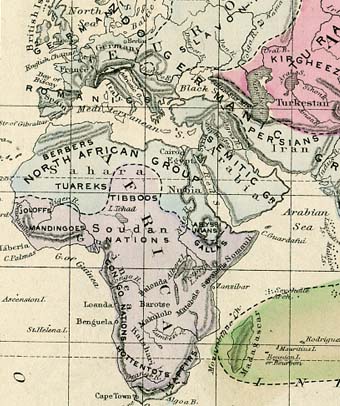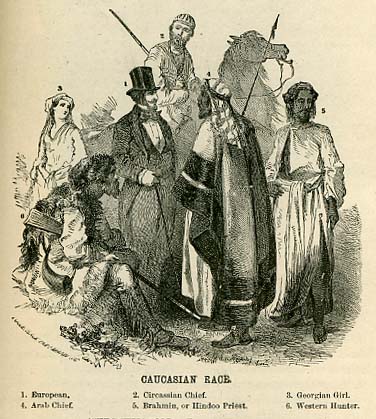
1. That all human beings have descended from a single pair, and that external causes such as differences of food, climate, mode of life, and local position are sufficient to explain the present diversities.
2. That the human race came into existence at different points on the earth, by simultaneous or successive creations, each being the source of a separate race and a separate family of languages.
3. That all the varieties of race are the result of a process of development or evolution, primarily from lower orders of life.

Having passed on the determination of the origin of the human race, the Victorian geographer is ready to set out the “races of menâ€. This is a rather long excerpt, but worth reading for all the absurd mistakes of working from the biblical table of nations and an undisguised prejudice. As you read through the quote, think of all the mistakes and note the self-promoting hubris of the “Aryan†(and right kind at that…) author:
1. The human family is divided into branches or races. But different naturalists have assumed different divisions: Buffon makes six varieties; Kant, four; Norton, twenty-two families; Pickering, eleven races; Latham, three.
Blumenbach’s division into five races, although proven not to be quite tenable, has been most widely accepted, and is therefore adhered to in this book.
2. This classification is based upon the physical properties of the various nations. The five races are: – (1.) The Caucasian. (2.) Mongolian. (3.) Ethiopian. (4.) Malay. (5.) American.
(1.) The Caucasian. This race is distinguished by the light color of the skin; straight or curling hair; the oval face; the vertical position of the teeth; and the well-formed, active, and graceful figure.
It inhabits Southwestern Asia, Northern Africa, nearly the whole of Europe, and, of late, large parts of North and South American and Australia. It is the truly cosmopolitan and historical race. The leading nations of the world, those who have reached the highest state of civilization and possess a history in the true sense of the word, belong to it. It has, therefore, not improperly been called the active race; while the others. embracing the uncivilized or half-civilized peoples, have been termed passive races.
The earliest home pf the Caucasians was doubtless in the western regions of High Asia, – perhaps near the Hindoo-Koosh Mountains. From here it descended and migrated to neighboring plains. The history of the world begins with these migrations.
The first branch that left their ancient home was the North African or Cushites, the descendants of the Ham of the Bible. It occupied Arabia, most of the southern sea-coast of Asia, the Abyssinian Highlands, the fertile valley of the Nile, and gradually spread over that part of Africa which lies between the Mediterranean Sea and the Sahara Desert.
The second branch was the Semite, – the descendants of the Shem of the Bible. It descended from its home in the Highlands, into the countries of Western Asia, the valley of the Euphrates and Tigris, Syria, and Arabia. The chosen people, the Israelites, and the Arabians, belong to it.
The third and most important branch was the Aryan, – the descendants of the Japhet of the Bible. It was the last to leave the old home of the race, and from it the principal European nations, with their descendants in other continents, have descended.
Wherever the Caucasian nations migrated, they found dark peoples belonging to the passive races. they either drove these away and forced them to seek new homes, or they conquered and enslaved them, or they intermixed with them.
Subdivision. – Three Branches
(1.) The North African Branch comprises the following nations: –
• The Nubians, of dark-brown color, lithe, active figures, and pleasing features. They live in Nubia, side by side with Arabian tribes.
• The Fellahs, descendants of the ancient Copts, in Egypt, of dark-yellow color, and black, curly hair.
• The Abyssinians of dark-brown color. They have been Christians since the fourth century, but their religion consists of empty ceremonies and superstitious images.
• The Berbers, inhabiting the Barbary States, on the shores of the Mediterranean Sea. They are light of color, resembling Europeans; brave, bold, and proud of character.
• The Moors, living in the cities of the Barbary States, are a mixture of Arabians and Berbers.(2.) The Semitic Branch comprises the following nations: –
• The Jews, or Hebrews, descendants of the ancient inhabitants of Canaan, living scattered in nearly all the civilized countries of the world.
• The Arabians, or light-brown color, tall, slender, and muscular figure, and highly poetical turn of mind. They consist of many different tribes, inhabiting Arabia, or living as nomadic Bedouins in the Sahara and Barbary, and as peasants in Egypt.
• The Aramaeans, including the Syrians and Chaldeans, in Western Asia.(3.) The Aryan Branch comprises the Germanic, Romanic, Slavonic, and Celtic nations of Europe; the inhabitants of America, Australia, and Africa, of European origin; the Iranians in Western Asia, and the Hindoos in India. We shall treat of the Aryans more fully hereafter.
The various nations inhabiting the valleys of the Caucasus Mountains, as the Circassians, and other, belong to the Caucasian race; but they appear not to be related to any of three branches above described.
The Basques, living in the western Pyrenees, stand alone, and have no affinity with any known nationality. They number about 650,000 souls.
Excerpts from D. M. Warren, An Elementary Treatise on Physical Geography. Revised by A. von Steinwehr. (Philadelphia, Cowperthwait & Co., 1873), 86-87.
In a previous post I discussed two lithographs from the 1873 edition of Warren’s geography. In another Warren’s view of the mirage was explored.